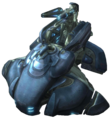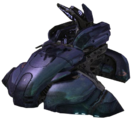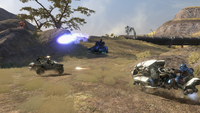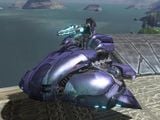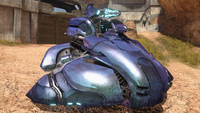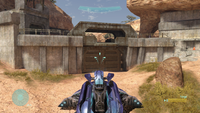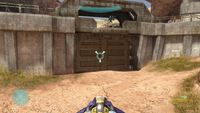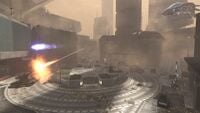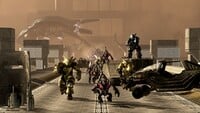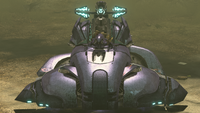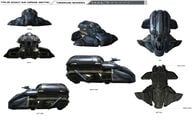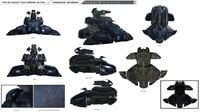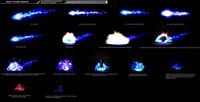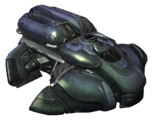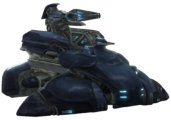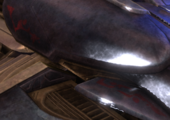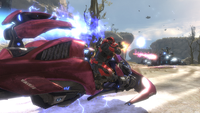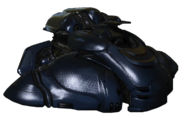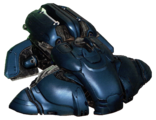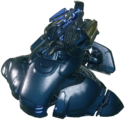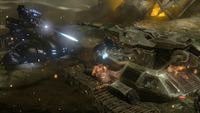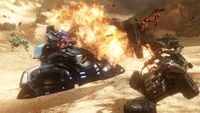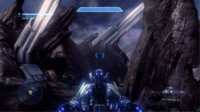Zurdo-pattern Wraith
From Halopedia, the Halo wiki
| Zurdo-pattern Mortar Tank | |
|---|---|
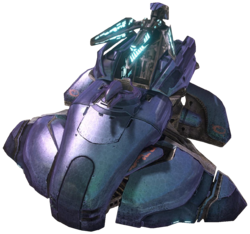
| |
| Production information | |
|
Manufacturer: |
|
|
Model: |
Zurdo-pattern |
| Technical specifications | |
|
Length: |
|
|
Width: |
|
|
Height: |
3.7 metres (12 ft)[2] |
|
Mass: |
|
|
Maximum speed: |
82 km/h (51 mph)[6] |
|
Engine(s): |
|
|
Hull: |
|
|
Armament: |
|
|
Crew: |
|
| Usage | |
|
In service: |
|
|
Role(s): |
Light assault gun carriage
|
|
Affiliation: |
|
The Zurdo-pattern Mortar Tank (UNSC Type classification: Type-26 Assault Gun Carriage, T-26 AGC),[4] more commonly known as the Wraith, is the Covenant's main armoured infantry support/assault gun vehicle for ground engagements.[2]
Overview[edit]
Design details[edit]
The Zurdo-pattern Wraith is the primary armored ground vehicle used by the Covenant.[8] The Covenant deploys Wraiths in tactical ground engagements, where they serve in both anti-infantry and anti-armor roles. The Wraith's firepower also makes it ideal for destroying structures.[7]
Like all Covenant ground vehicles, the Wraith is sleek, bulbous and more reminiscent of an aircraft than a traditional ground vehicle. The Wraith is divided into four main sections: chassis, fins, rudders, and plasma mortar. The chassis houses the cockpit, which includes movement, targeting and firing controls. Holographic control surfaces and displays show the pilot a 360-degree view outside the Wraith.[9] Underneath the cockpit is a boosted gravity propulsion drive,[10] which propels the Wraith and keeps it suspended a short distance above the ground. The Wraith's engine vents excess heat and plasma through an exhaust port at the rear of the vehicle; this port is one of the more vulnerable spots on the Wraith. The wide, sweeping fins at the front of the vehicle stabilize the vehicle on uneven terrain, as well as provide extra thrust during a boost.[10] At the rear of the Wraith are two rudders, which control the turning of the vehicle using independent propulsion drives. The fourth major component is the Wraith's main weapon, a heavy plasma mortar, which rests above and behind the cockpit and can be retracted within the main body. The entirety of the Wraith is covered by nearly two feet of armor plating, which is composed of a polymer that is still poorly understood by human physicists.[4]
Armaments[edit]
The main weapon of the Wraith is its 35cm heavy plasma mortar.[3] The Wraith's mortar is attached to a fixed mounting, meaning that a Wraith must be facing its target in order to hit it.[4] The plasma mortar works by creating a magnetically encapsulated blob of superheated plasma and firing it at a relatively low velocity. Once fired, the bolt is magnetically guided in a ballistic trajectory until it strikes the ground or target. When the bolt hits, the magnetic bubble collapses and the plasma rapidly expands from its compressed state, creating a superheated explosion that will vaporize everything within twenty meters of impact.[11] Titanium battleplate, concrete, or flesh is instantly obliterated by the blast. Anything just outside of the kill zone is at risk of injury or death — after the initial impact, the plasma begins to cool and thermal expansion takes over, creating a wave of fire traveling outward that can travel away from the initial blast zone. Infantry within range can sustain burns and heat trauma. The explosion also generates a large amount of concussive force, which can splinter bones and destroy vital organs.[12] Flammable materials are especially at risk of igniting due to the intense heat release and can cause further damage. Once the heat from the explosion dissipates, the blast zone will have been converted into a glass-smooth surface - much like the swaths of vitrified soil created by "glassing".
The Wraith is also equipped with an anti-infantry T-26 DEWE light plasma cannon.[3] This turret is able to burn through armor and flesh, with predictably gruesome results. Against infantry, the cannon's plasma causes severe fourth-degree burns.
All Zurdo-pattern Wraiths made after 2549 featured a ring mount for the light plasma cannon,[3] allowing an additional crew member on the Wraith.[13][14]
Advantages[edit]
With the exception of the Scarab, the Wraith is the Covenant's most destructive mobile armor. Its huge bulk is well shielded from small arms fire, and it is resistant to medium explosive weapons. Its ability to be deployed with the aid of dropships makes insertions into the battlefield fairly easy. Its plasma mortar can easily decimate infantry and vehicles alike, and its destructive powers are so well known to UNSC forces that the mere sight of one on the battlefield can induce psychological effects.[11] One of the benefits is the mortar function due to the trajectory that can suppress any incoming enemy from behind the wall, or those who are stationed at the rooftop that can't be reached by a Scorpion Tank's trajectory. While it's not suitable for head to head battle, it is most suitable to conduct a suppression fire mainly against enemy infantry.
Disadvantages[edit]
The Wraith's main disadvantage is its slow speed, due to the vehicle's massive weight. While the boost drive can propel the vehicle to moderately high speeds, the maneuverability of the vehicle is compromised — turning becomes difficult during a boost, and the momentum that is built from it makes it possible for the vehicle to inadvertently plow through friendly forces, crash into and get lodged between stationary objects, or overshoot its mark and skate off of a cliff or into a body of water. The Wraith is also poorly suited for scaling inclines.
Like most tanks, the Wraith has a "dead area", a zone in which the plasma mortar cannot fire without risking damage to itself.[15] The slow speed and cumbersome nature of the Wraith makes it prone to boarding action — while the front of the tank is harder to board because of the plasma turret(s), the rear is highly susceptible to boarding. A small rotating cylinder exhaust port in the back is a vulnerable spot that, if hit with a medium explosive device or anti-materiél weapons fire, can damage the tank severely. The exposed gunner operating the Type-52 DESW is also an easy target for marksman and sniper fire.
Since its weaponry is designed to be used against non-mobile or low-mobility targets, and its weight and wide profile prevent it from maneuvering with any deal of speed and accuracy, the Wraith is a very soft target for high mobility vehicles, such as a Warthog or a Ghost, and is at a high risk of destruction against a vehicle with a much more accurate heavy weapon (such as the Scorpion with its direct-firing 90mm cannon).
The Plasma Mortar is also ill-suited for long range combat, as it moves so slowly that even units with low mobility-such as the Scorpion tank-can dodge it.
Operational history[edit]
Human-Covenant War[edit]
The Wraith has been in service to the Covenant for centuries,[16] and has served in countless engagements during the Human-Covenant War. After the retaking of Harvest in 2526 by Admiral Cole, the Covenant, attempting to scout and recover an artifact, deployed multiple Wraiths during the assault on Harvest.
Throughout the war the Covenant deployed Wraiths during ground campaigns against civilian and military targets. Wraiths would commonly target civilian evacuation transports still on the ground and platforms and structures leading to them, or would fire and kill large groups of civilians crowded together. In 2531, during the first assault on the colony world Arcadia, multiple Wraiths were used in this situation to kill panicking civilians attempting to flee the Covenant invasion. The tanks assisted in destroying structures and platforms holding civilians waiting for evacuation. In addition, the tanks were used against UNSC military forces attempting to assist with evacuation efforts.[17] During the Battle of Trove, Wraiths were used by Covenant forces against not only the crew of the UNSC Spirit of Fire but also the Flood and Sentinels as well.[18]
As the war dragged on, ground campaigns conducted by the Covenant continued to employ the Wraith as their main heavy armored vehicle. During the assault on Algolis the Wraiths were called in to weaken military forces attempting to protect and destroy valuable data. The UNSC was able to hold off the Covenant just long enough and all ground forces were eventually destroyed with the detonation of a nuclear weapon attached to a prototype armor suit.[19]
As the war with humanity was reaching its apex, the Covenant began updating and building up their military campaign against humanity. After 2549, all models of the Zurdo-pattern Wraith were equipped with a ring mount for a secondary gunner to operate the Wraith's plasma cannon.[13][14] During the invasion of Sigma Octanus IV in July 2552 the Covenant deployed numerous tanks to take out strategic areas on the planet including military bases and civilian structures.[20] No sooner had that battle finished the Covenant launched a surprise assault on Reach, humanity's heavily fortified epicenter of military and economic power outside of Earth. Multiple divisions of Wraith tanks were employed to inflict mass casualties on civilian and military forces alike. Their campaign was successful destroying major military and civilian transports, structures and killing countless in the process.[21][22]
During the opening of the Battle for Earth, the Solemn Penance managed to jump to the city of Mombasa. In the short but bloody campaign, the Covenant was able to land armor and troops into the city. Wraiths quickly moved in to cut off civilian evacuation by the city's rail system.[23] With civilians cut off, the Covenant began systematically destroying anything they could before the Prophet of Regret's ship jumped out of New Mombasa, destroying parts the city.[24] In the aftermath of Regret's retreat the full-scale invasion of Earth began, the Covenant laid waste to many parts of the planet and Wraiths were on the forefront of the ground assault.[25][26]
With the uncovering of the Portal at Voi, the Covenant moved all their troops and armor to prevent the UNSC military from getting close to it. They deployed Wraiths to dispatch military forces attempting to break through their formation.[27][28] After the opening of the portal and the arrival at Installation 00 the Covenant deployed all their assets in a last ditch effort to stop humanity and activate the remaining Halo installations. Wraiths were front and center in this operation, although ultimately, they lost to their human enemies.[29][30]
Post-War[edit]
During the post-war period, Wraiths were popular during War Games matches aboard Anvil Station and the UNSC Infinity. Wraiths were used by Merg Vol's Covenant during the Battle of Draetheus V in 2554. Many would be destroyed by both Spartans Sarah Palmer and Edward Davis with the help of the UNSC Marine Corps and UNSC Army.[31][32] Four years after the end of the Human-Covenant War, Jul 'Mdama's Covenant continued to use the Wraith. Multiple Wraiths were used in the attack on the UNSC Infinity's crash site.[33] Several were later used in defense of the Forerunner particle cannons.[34] Wraiths were also used during the Didact's Raid on Ivanoff Station in their attempt to secure the Composer.[35] The faction utilized a number of Wraiths during the Battle of Installation 03.[36] Wraiths were deployed to many sites across the interior of Requiem during the combat within the planet six months later.[37][38][39] 'Mdama's faction would again use Wraiths during the conflict on Aktis IV. A rebel offshoot of 'Mdama's faction led by Sali 'Nyon also possessed at least one Wraith.[40] During Operation: ATHENA 'Mdama's forces used multiple Zurdo-pattern Wraiths in an attempt to stop a team of Spartan-IVs.[41]
By October 2558, the newer Kemu-pattern Wraith was becoming more commonplace within Jul 'Mdama's Covenant forces and the Swords of Sanghelios.[42]
Trivia[edit]

|
See our gameplay information related to Zurdo-pattern Wraith on its gameplay page. |

|
Browse more images in this article's gallery page. |
- It is wrongly stated in the Halo 2 manual that the player can shoot the Wraith's plasma cannons while driving; these are usable only by NPCs in gameplay. The Halo 3 manual claims that the Wraith features the aforementioned cannons, though they appear only in Halo 2.
- An abstract depiction of the Marathon logo is embedded in the Wraith's cockpit in Halo: Reach. Bungie limited their use of Marathon references in the game due to intellectual property concerns, as opposed to the logo's frequent appearances in the original trilogy.
- In Halo: Combat Evolved Anniversary, the Wraith's model was carried over from Halo: Reach with no changes. As such the T-52 plasma cannon is still mounted on top, though it is not usable. Conversely, the Scorpion tank's independently mounted machine gun was removed entirely.
- It is possible, though difficult, to hijack a Wraith by hopping in the mounted turret while an enemy is still inside of it, while not harming the Wraith. In Halo Reach and Halo 4, in Campaign, Firefight or Spartan Ops, respectively, if the player is able to get in the turret while an enemy NPC driver is still in, the driver will hop out and usually start shooting at the player, after which the player can dispatch the enemy with the turret and claim the Wraith, possibly with it being undamaged.
- Since Halo 4, if the player presses the melee button while boosting, the Wraith will perform a super glide, in which the vehicle lifts its nose to pass over obstacles, while also making splatters a little bit easier.
Gallery[edit]
Halo 3[edit]
An active Wraith on Highground in multiplayer.
Halo 3: ODST[edit]
A Wraith fires its mortar at Mickey's Scropion.
Covenant infantry supported by Wraiths in an assault on ONI Alpha Site.
The Flood using a Wraith in Firefight in Halo: The Master Chief Collection.
Halo: Reach[edit]
Render of an inactive Wraith in the Halo: Reach Multiplayer Beta.
A Rizvum-pattern Revenant fighting two Wraiths.
Halo 4[edit]
A Wraith battling an M808 Scorpion.
John-117 throws a plasma grenade on a Wraith.
List of appearances[edit]
Sources[edit]
- ^ a b c Halo: The Essential Visual Guide, page 206
- ^ a b c d e f g h i Halo Encyclopedia (2022 edition), page 275
- ^ a b c d e f Halo 4: The Essential Visual Guide, page 117
- ^ a b c d e f Halo Encyclopedia (2009 edition), page 247
- ^ a b c Halo Encyclopedia (2011 edition), page 257
- ^ Halo Waypoint, Wraith (Retrieved on May 11, 2021) [archive]
- ^ a b Halo 2, Special Collector's Edition Manual: page 17
- ^ Bungie.net, Halo: Reach Ordnance Page (Retrieved on Feb 7, 2021) [archive]
- ^ Halo: First Strike, page 113
- ^ a b Halo 2, manual: page 19
- ^ a b Halo: First Strike, page 112
- ^ Halo: Evolutions - Palace Hotel, page 351
- ^ a b Bungie.net, Halo 3 ODST Career Stats: "All post-2549 model Wraiths have an extended crew area with a Type-52 DESW in a ring mount." - Wraith - Gunner tooltip description (Retrieved on Dec 22, 2013) [archive]
- ^ a b Bungie.net, Reach : Career Stats: "All post-2549 model Wraiths have an extended crew area with a Type-52 DESW in a ring mount." - Wraith Type-26 AGC (Gunner) tooltip description (Retrieved on Jul 19, 2019) [archive]
- ^ Halo: The Flood page 184
- ^ Halo Legends, episode The Duel
- ^ Halo Wars, campaign level Arcadia City
- ^ Halo Wars, campaign level Beachhead
- ^ Halo Legends, episode Prototype
- ^ Halo: The Fall of Reach, chapter 19
- ^ Halo: Reach, campaign level Tip of the Spear
- ^ Halo: Reach, campaign level Exodus
- ^ Halo 3: ODST, Sadie's Story
- ^ Halo 3: ODST, campaign level Prepare to Drop
- ^ Halo 3: ODST, campaign level Kizingo Boulevard
- ^ Halo 3: ODST, campaign level ONI Alpha Site
- ^ Halo 3, campaign level Tsavo Highway
- ^ Halo 3, campaign level The Storm
- ^ Halo 3, campaign level The Ark
- ^ Halo 3, campaign level The Covenant
- ^ Halo: Spartan Assault, campaign level Mission 4: Live to Fight
- ^ Halo: Spartan Assault, campaign level Mission 10: Battle at Red Slate
- ^ Halo 4, campaign level Infinity
- ^ Halo 4, campaign level Reclaimer
- ^ Halo 4, campaign level Composer
- ^ Halo: Spartan Strike, campaign level Mission 9: Lockout
- ^ Halo 4 - Spartan Ops, episode Departure, level Land Grab
- ^ Halo 4 - Spartan Ops, episode Catherine, level Shootout in Valhalla
- ^ Halo 4 - Spartan Ops, episode Expendable, level Unfinished Business
- ^ Halo: Escalation, issue #24
- ^ Halo: Escalation, issue #20
- ^ Halo Waypoint, Canon Fodder - Designs of the Times (Retrieved on Aug 26, 2021) [archive]
| |||||||||||||||||


